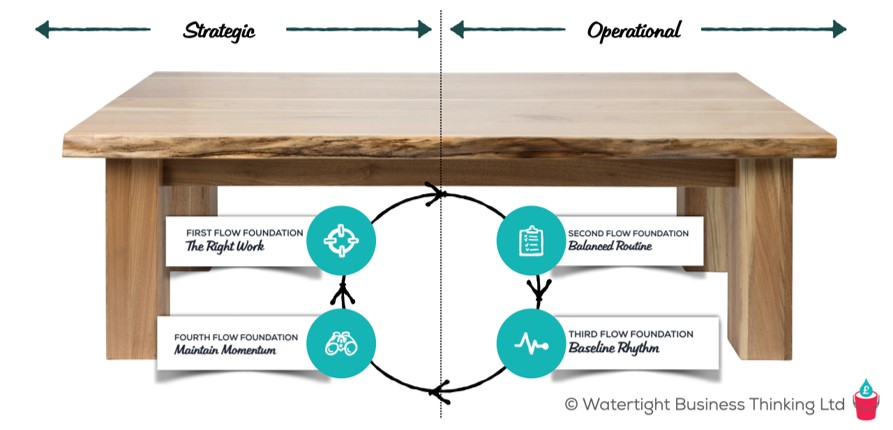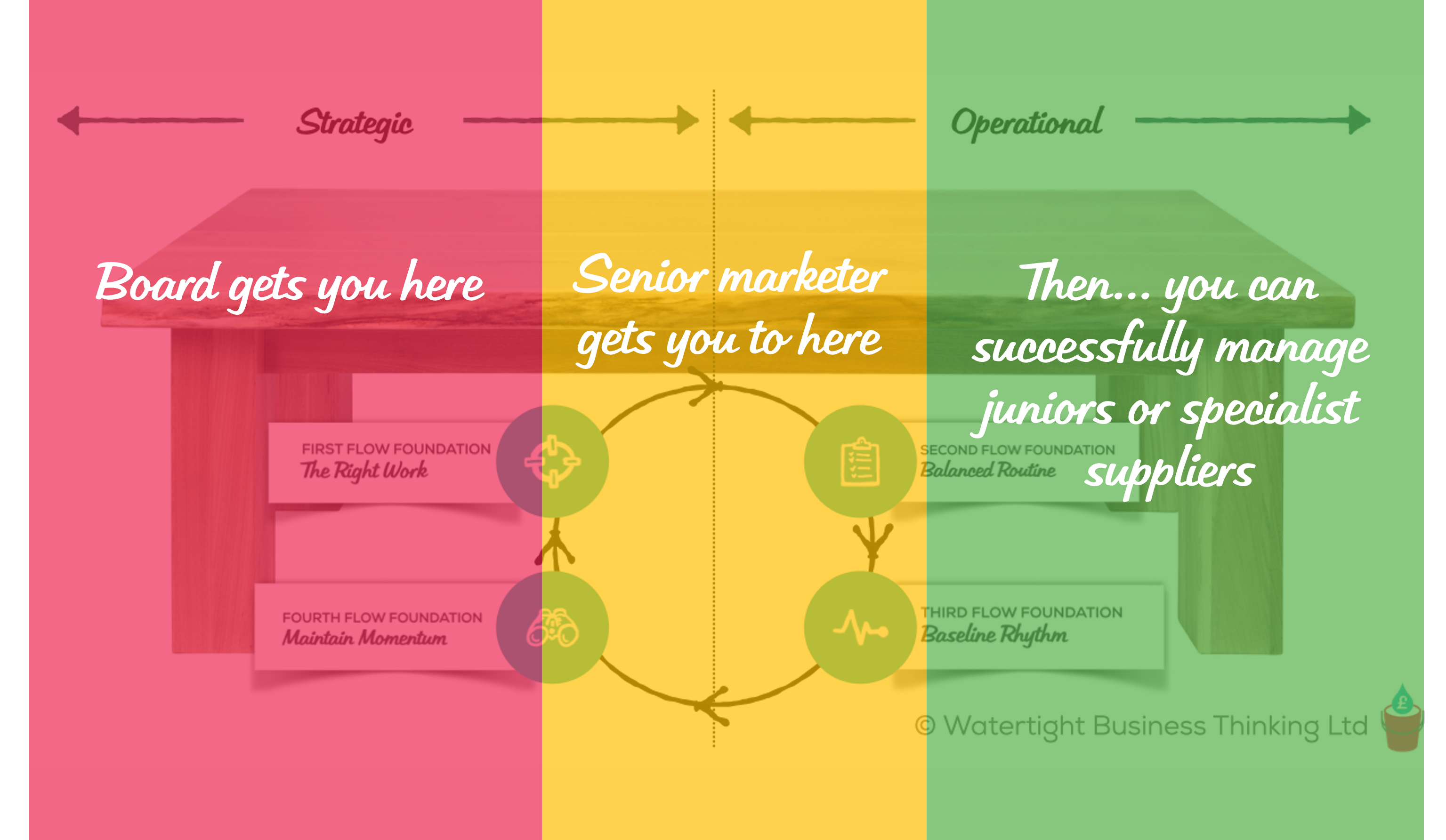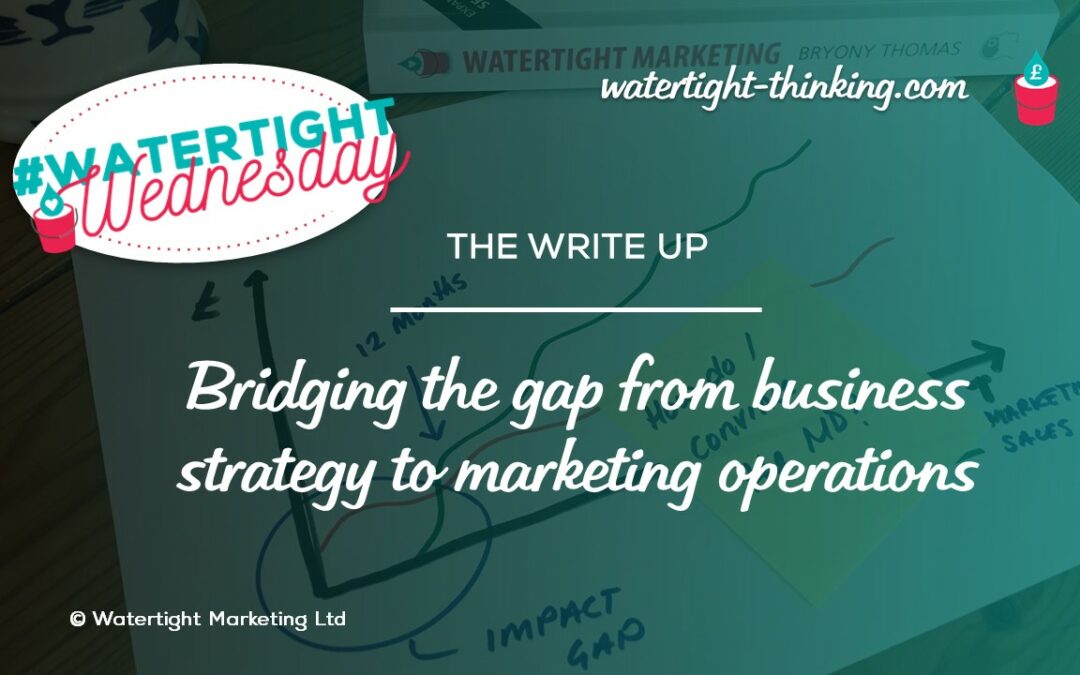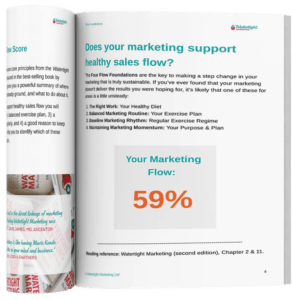Reading Time: 10 Minutes
“A key role of marketing is to make sure the strategy, plan and activity supports the business’s objectives. Without that, the risk is scattergun marketing and it’s hard to prove the value of marketing. In our latest roundtable we talk about why this gap occurs and how to bridge it.” ~ Rachael Wheatley, Managing Director | Watertight Business Thinking
Listen to the session podcast here
49-minute roundtable discussion on bridging the gap from business strategy to marketing operations.
Is your marketing strategy and plan based on a business plan? That was the straw poll we started with. The majority of responses were “no”. However, everyone saw the gap and recognised what was needed, even if that is only short term objectives relevant to the next 12 months. Whatever the time frame, marketing needs context to be truly effective.
Without this gap being bridged, marketers are in an invidious position. They’re challenged on the impact and ROI of marketing, but unable to prove it – beyond the very tactical – because it operates in a vacuum, unrelated to what the business wants to achieve. This necessarily leads to wasting time and money on marketing that doesn’t work. It might bring in new leads – but are they the right ones? It might help sales to engage with warm prospects – but are the topics relevant and is the proposition meeting their needs? It might lead to happier and more loyal customers – but are they profitable and motivating to deal with?
Without the leadership team being able to answer these questions first, it’s difficult to see how you can translate what can be very vague objectives (grow the business) into an action plan that’s tangible and effective.
What’s the gap?
Imagine the Four Foundations of successful marketing as a table, where the two legs on the left are strategic and the two on the right are operational.

For the first and fourth Flow Foundation, the leadership team will be involved. They will need to understand both to a reasonably deep level and will be part of discussions on vision, values, milestones, products, competition, proposition, customers and market dynamics.
What we often see is that even if these conversations occur and any plan or objectives have been agreed, there is a jump to the right – the two operational Foundations – when they ask the marketer, the marketing team or an external agency to make things happen. It’s a leap directly from business strategy to tactics.
What’s often missing is the piece in the middle. That’s usually a person – a senior marketer, sufficiently experienced and trained (either employed or a consultant) that acts as that bridge between what the leadership team have agreed and putting that into operation via a marketing strategy and plan.
You can outsource the tactics, if need be, if you don’t have (all of) the resources in-house. You can even outsource the person in the middle by seeking a consultant or part-time CMO. But you can’t outsource the strategic bit. And, if that’s missing – i.e. there is no clear vision or plan, no objectives or milestones, whether long, medium or short term ones – that’s the first gap. The second gap is if you don’t have someone who can do the translation piece and properly shape and manage the marketing operation.
Why does the gap occur?
We identified six key reasons here:
- No business plan. As mentioned before it’s impossible to have a fully functioning, effective marketing plan without knowing the context within which that plan sits. Quick wins are possible, however, so although the plan sets out a longer term roadmap, the milestones to work towards can be shorter term and these can frame the marketing plan.
- Numbers not narrative. The plan lacks anything more than a few numbers – desired revenue or profit figures. Understanding what those numbers mean and breaking them down a bit will help shape the marketing. So, how many new clients do these numbers represent. What opportunities are there within the existing client base? How can we motivate staff with a vision or purpose that brings these numbers to life?
- Perception of marketing. It’s an old chestnut, but we still see it. It’s where leaders and managers pigeon-hole marketing as purely lead generating and colouring in.
- Don’t see the value of marketing. Related to no. 3 where sales is seen as the department directly bringing in revenue, and the need for marketing is questioned.
- Experience of marketing. Perhaps the experience of marketing in the past hasn’t been great and so it’s written off as a waste of time or money and lacks credibility. In this case, it’s not clear what ‘good’ looks like.
- Tactics not strategy. Where the focus is on tactics without considering the need for, or seeing, the thinking and rationale behind them.
There was an interesting discussion around the difficulty in getting to a business plan. Indeed, in a start-up or small business, you might well need to be more pragmatic so as not to hold out for something that’s not going to happen, at least quickly. Whilst progressing the bigger projects – a business plan or a brand positioning exercise – marketing activity still needs to happen. You still need to give people a sense that things are happening and moving forwards. Your timescales here are the next quarter or six months, perhaps the next year.
“I joined a company last November. They’re still fairly young – only about seven years old – and they’re reverting back to start-up mentality. They’ve got some aggressive growth targets, but that’s the only business objective they’ve got. When I asked about a strategic business plan, the CEO said: it’s in my head. A plan has not been forthcoming.” (Product Marketing Manager)
Even in these scenarios, some degree of context is needed: some sight of the next milestone and understanding of the ideal customers and proposition, for instance.
Other reasons mentioned above were echoed in the room. A previous senior marketing executive taken on by one company who wasn’t sufficiently strategic or experienced and so didn’t last; a company driven by sales people, where marketing is focused solely on lead generation; an organisation very siloed making it an uphill struggle to position marketing credibly across the business supporting sales, customer services and product development; a CEO needing to slow down and finish one thing before moving on to the next.
“I started off in a B2C environment. I find that in B2C, it’s a lot easier to get marketing in front of your board and CEO and influence things. My experience of B2B – I work in an engineering focused company – is that marketing is very much the shiny things. It’s not the strategy, but it’s the paper that you print your product spec on or social media. So all the pieces around strategy, thinking long term, it’s a lot more challenging to get marketing top of mind and to get them to think what marketing can do for them.” (Strategic Marketing Manager)
What you can do about bridging the gap
Back our Flow Foundations table.
The board will get you part-way (the red bit, below). It’s an area that the senior marketer needs to be fully involved with, and actively contributing to. These are the discussions around what you’re selling, to whom. The market landscape, the proposition and how it meets customer needs. It also includes having more than a vague notion of what the business is aiming for.

The senior marketer acts as the bridge. Taking the business plan and objectives and operationalising it as a marketing strategy and action plan, identifying the necessary strategic projects.
The person who performs this role is a generalist who knows enough about the different areas of marketing to choose the right tools and resources. They’re pushing for excellence whilst maintaining momentum. They:
- See the big picture and translate business goals into actionable marketing strategies.
- Make sure everyone involved is delivering the strategy to the same hymn sheet.
- Are the architect and work on a plan showing how the different parts fit together.
- Act as team coach, knowing when to bring in specialists.
- See every part of the marketing strategy as an activity, carefully piecing it together.
- Work hard to make sure everyone involved knows the part they play and feels valued.
See: What skills does a marketing director need to be really effective?
“I would just say my experience at the moment is to your point about building credibility. I’ve come into a role as a head of department to do things the right way, taking all my learnings from 12 years or so at various companies. That’s not necessarily what the board wants. The board wants me to do stuff, so they don’t necessarily understand yet. So it’s more about building my credibility with them. It’s definitely about relationship building.” (Head of Marketing).
Another aspect of relationship building that came up was to do with stakeholders. As one global marketing manager explained, it makes bridging the gap more complex because you’re not just dealing a board, you have multiple stakeholders around the world to engage and convince.
It’s tough, balancing what the shareholders want – and you want to keep them on-side – with the desire to add value and do things the right way. The problem here is that if you always do what the board wants, without, at some point, pushing back and challenging this, it’s hard to demonstrate the value of marketing and you’re stuck in this loop that perpetuates a certain view of marketing as a function that doesn’t add value.
Liz Davidson: “I’m on the board, head of marketing, and doing the marketing. I have at some points found myself digging into a position which perhaps was overly conservative because I felt pressured. But, it’s a tricky path to navigate. It’s getting easier; we’re a bit bigger now and there’s a bit more resource to outsource stuff. If you’re across the whole thing (board, bridge and operations), it’s not easy going wearing that many hats or going from high level down to detail. The detail takes large chunks of time.”
An educative piece can help to bridge the gap. We often start a client engagement with a team day going through our four Flow Foundations with the board. We feedback results of a cohort report from people who’ve filled in our marketing fitness test and that starts to bring strategic marketing to life and change people’s perceptions.
What makes life easier is a good relationship between you and your boss – often the CEO or MD. If that works, you have an ally and champion and it becomes easier to perform that bridging role.
There was a sense in which bridging the gap happens over time but also every day. Especially if marketing is quite new to the business, it requires a change of mindset. And the openness to try different things – pilot a new approach, get a campaign up and running.
“I think it’s an ongoing conversation, a daily challenge. I think that we just have to push on and raise the awareness of what marketing is. A lot of people don’t realise what marketing actually does. It’s just a continuous process of building that momentum and the trust, and showing them your capabilities and expertise. It’s an ongoing process.” (Strategic Marketing Manager)
“It’s like exercising and building stamina. I have to revisit it every day.” (Product Marketing Manager)
Don’t forget about sharing successes, too. “Sometimes we shy away from this, but even an email to put in front of people to say, look, this worked. If something failed, be honest and say so and why and what you learned, what you’d do differently next time.”
Watertight Wisdom
What’s worked for us
Eight nuggets from around the room:
-
- Build credibility and trust first. Before you can bridge the gap, you need to build credibility and trust. In that sense, bide your time and then you will have earned the right to challenge things.
- Put the building blocks in place. If not there already. This year, next year. Short and long term goals so that you can put the marketing plan in that context and show you’re choosing the right tools.
- Communication. This is as much about relationship building with all stakeholders (time-consuming as that is) as it is about sharing your plan with the wider business and drawing a line directly from what the business wants to achieve and why you’re therefore putting in place those marketing activities you’re planning.
- Use the support of other people to help you in your bridging role. The relationship between you and your boss is particularly important, but there will be other allies around the business.
- Account for remote working. Bridging that gap is made more complex with remote or hybrid working because it will involve working in teams, facilitating group discussions and building relationships one to one. It’s not impossible, but is likely to take longer.
- Repetition. Keep the faith and use the same language, consistently and repeatedly. It’s especially useful if you don’t see certain people often. Go back to the same points, remind people. Use analogies and metaphors to bring your thinking to life.
- Consider the different aspects of the bridging role and how that works in practice. You are a strategist, coach, architect, conductor and more! Explore what these all entail. How can you do those jobs to the best of your ability?
- Keep the big picture in mind but don’t forget the quick(er) wins. It is possible to do both – and gives people a sense of moving forward whilst you are also progressing the strategic bits.
What would you add to our list? Do let us know your thoughts.
To join the conversation at our next Watertight Wednesday marketing roundtable in March sign up here. We’ll be having a chin-wag about building credibility. Interestingly, this was something brought up in February’s discussion, so we’ll take a deeper dive into how you do that.
Do come along and share your experience with others and tap into ideas from the room about how to achieve success.

Rachael Wheatley
Managing Director, Watertight Thinking
Rachael brings over 30 years’ of marketing experience, with a particular focus on building and developing effective marketing teams that are able to act as a strategic driving force across an organisation. She has worked with Watertight since 2014 as a Master Practitioner and joined the business as MD in 2022.



